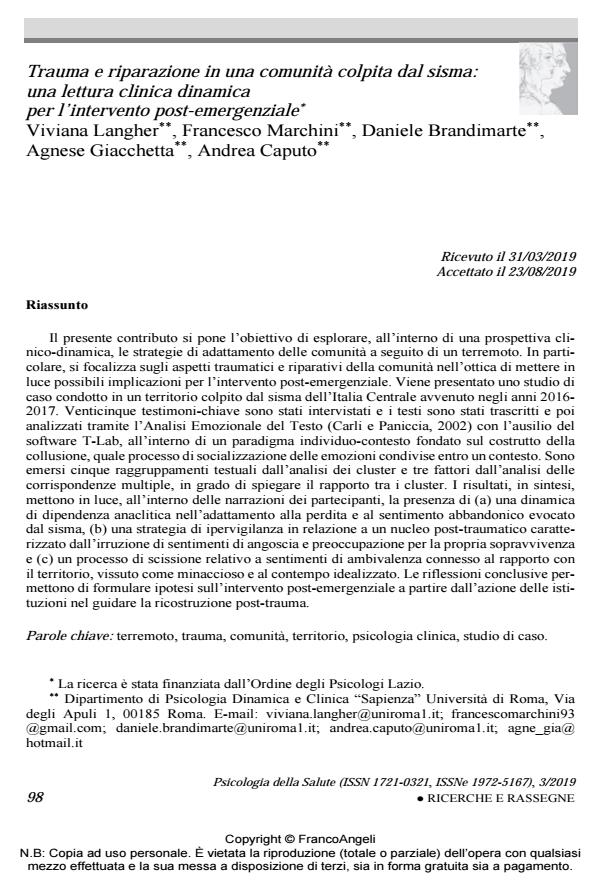Trauma e riparazione in una comunità colpita dal sisma: una lettura clinica dinamica per l’intervento post-emergenziale
Titolo Rivista PSICOLOGIA DELLA SALUTE
Autori/Curatori Viviana Langher, Francesco Marchini, Daniele Brandimarte, Agnese Giacchetta, Andrea Caputo
Anno di pubblicazione 2019 Fascicolo 2019/3
Lingua Italiano Numero pagine 24 P. 98-121 Dimensione file 278 KB
DOI 10.3280/PDS2019-003006
Il DOI è il codice a barre della proprietà intellettuale: per saperne di più
clicca qui
Qui sotto puoi vedere in anteprima la prima pagina di questo articolo.
Se questo articolo ti interessa, lo puoi acquistare (e scaricare in formato pdf) seguendo le facili indicazioni per acquistare il download credit. Acquista Download Credits per scaricare questo Articolo in formato PDF

FrancoAngeli è membro della Publishers International Linking Association, Inc (PILA)associazione indipendente e non profit per facilitare (attraverso i servizi tecnologici implementati da CrossRef.org) l’accesso degli studiosi ai contenuti digitali nelle pubblicazioni professionali e scientifiche
Il presente contributo si pone l’obiettivo di esplorare, all’interno di una prospettiva clinico-dinamica, le strategie di adattamento delle comunità a seguito di un terremoto. In particolare, si focalizza sugli aspetti traumatici e riparativi della comunità nell’ottica di mettere in luce possibi-li implicazioni per l’intervento post-emergenziale. Viene presentato uno studio di caso condot-to in un territorio colpito dal sisma dell’Italia Centrale avvenuto negli anni 2016-2017. Venti-cinque testimoni-chiave sono stati intervistati e i testi sono stati trascritti e poi analizzati tramite l’Analisi Emozionale del Testo (Carli e Paniccia, 2002) con l’ausilio del software T-Lab, all’interno di un paradigma individuo-contesto fondato sul costrutto della collusione, quale processo di socializzazione delle emozioni condivise entro un contesto. Sono emersi cinque raggruppamenti testuali dall’analisi dei cluster e tre fattori dall’analisi delle corrispondenze multiple, in grado di spiegare il rapporto tra i cluster. I risultati, in sintesi, mettono in luce, all’interno delle narrazioni dei partecipanti, la presenza di (a) una dinamica di dipendenza ana-clitica nell’adattamento alla perdita e al sentimento abbandonico evocato dal sisma, (b) una strategia di ipervigilanza in relazione a un nucleo post-traumatico caratterizzato dall’irruzione di sentimenti di angoscia e preoccupazione per la propria sopravvivenza e (c) un processo di scissione relativo a sentimenti di ambivalenza connesso al rapporto con il territorio, vissuto come minaccioso e al contempo idealizzato. Le riflessioni conclusive permettono di formulare ipotesi sull’intervento post-emergenziale a partire dall’azione delle istituzioni nel guidare la ricostruzione post-trauma.
Parole chiave:Terremoto, trauma, comunità, territorio, psicologia clinica, studio di caso.
- A systematic review of psychodynamic theories in community psychology: Discovering the unconscious in community work Andrea Caputo, Manuela Tomai, in Journal of Community Psychology /2020 pp.2069
DOI: 10.1002/jcop.22407 - The Impact of Past Trauma on Psychological Distress: The Roles of Defense Mechanisms and Alexithymia Siqi Fang, Man Cheung Chung, Yabing Wang, in Frontiers in Psychology 992/2020
DOI: 10.3389/fpsyg.2020.00992
Viviana Langher, Francesco Marchini, Daniele Brandimarte, Agnese Giacchetta, Andrea Caputo, Trauma e riparazione in una comunità colpita dal sisma: una lettura clinica dinamica per l’intervento post-emergenziale in "PSICOLOGIA DELLA SALUTE" 3/2019, pp 98-121, DOI: 10.3280/PDS2019-003006